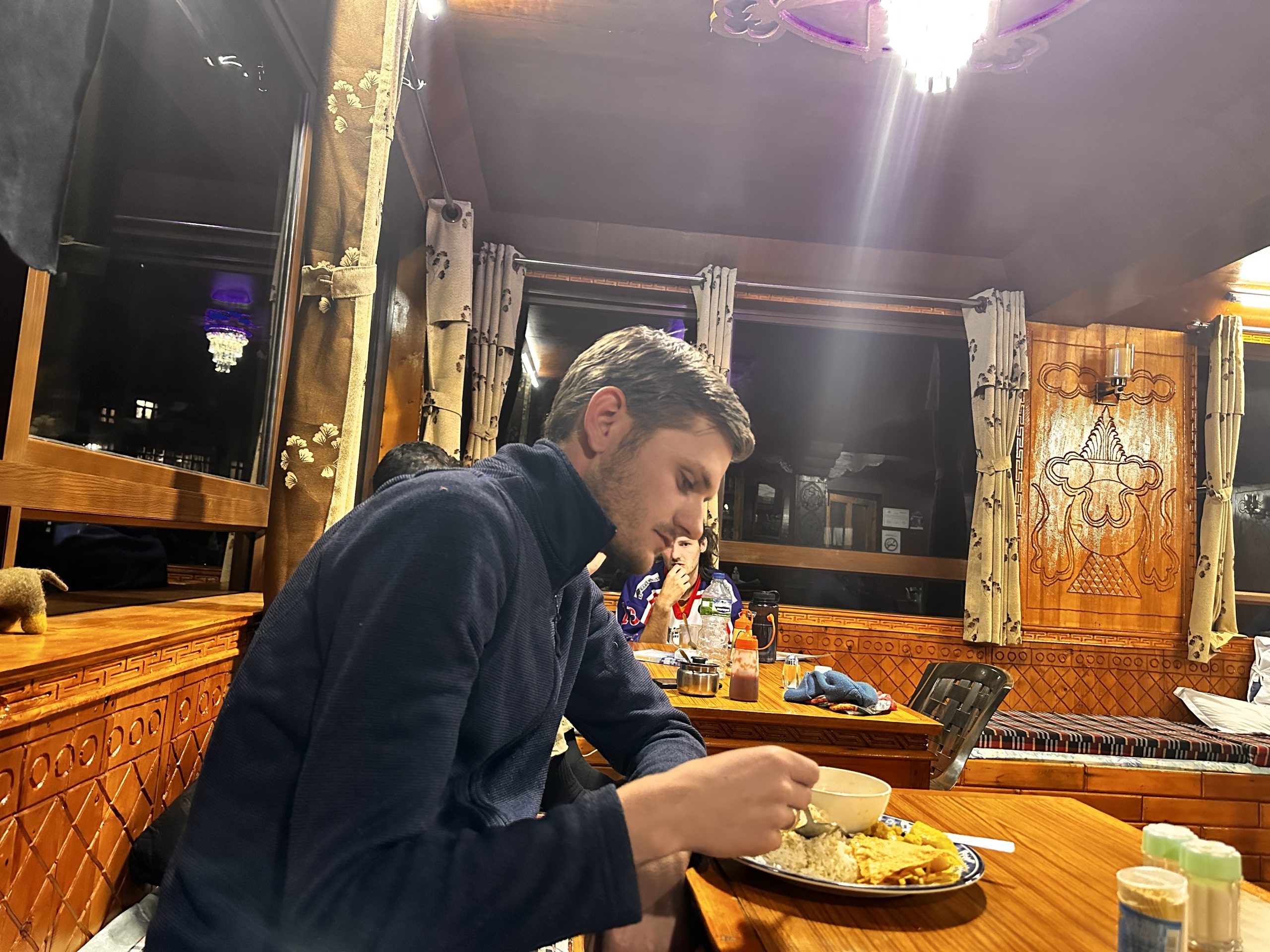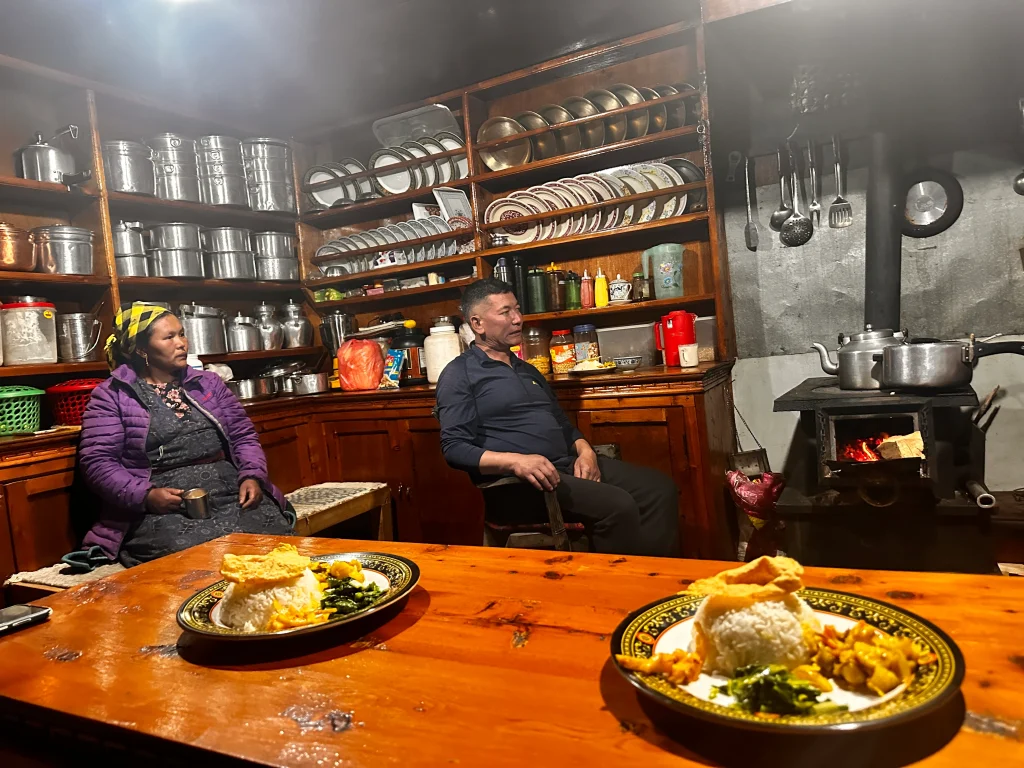
Introduction
Langtang Trek is a perfect blend of cultural experience and breathtaking mountain views located close to Kathmandu. It is a popular option when doing a moderate-duration trek, as it attracts nature lovers who do not want to face the extreme altitude issues.
Information on food and accommodation on the Langtang Trek is useful in equipping the trekkers. Food and accommodation make the trek more comfortable, safe, and cost-effective. This background makes it possible to enjoy a smooth trekking experience.
Most accommodation in the Langtang Trail is teahouses, simple but comfortable accommodations. Knowledge of the diversity and quality can guide trekkers to make appropriate stops. There is a wide variety of food choices, depending on location and altitude, which affects nutrition and energy.
This guide contains a lot of information on teahouse standards, the food available, prices, and food safety tips. Readers will find out how to organize meals and accommodation to make the most of their comfort and health during the Langtang Trek.
Food on the Langtang Trek
What to Expect in Tea Houses
The Langtang Trek has teahouses where traditional Nepali foods such as dal bhat, soups, and thukpa are available, and which are a good source of nutrition when trekking. They are energy-dense, delicious dishes that contain a lot of protein and carbohydrates.
There is usually access to Western food, such as pasta, pancakes, omelets, and fried rice. These are comforting meals that trekkers can enjoy when they are in need of familiar flavors. The quality varies depending on the tea house, but most meals are hearty and fulfilling.
Hot beverages such as tea and coffee are also sold in large amounts, being essential in keeping the body warm in cold mountain conditions. Biscuits, chocolate bars, and instant noodles are also not too hard to come by and are quick energy boosts between meals.
Food varieties are good, but availability is determined by the location and supply conditions of the teahouse. Trekkers will also face the problem of occasional shortages at higher altitudes, so carrying some snacks as a secondary measure should help keep them energized during the trek.
Pricing and Variety by Altitude
To the benefit of the trekkers in the Langtang Trek, there is a broader choice of cuisine in the lower altitude villages, usually between $4-$8 per meal. These regions have the advantage of supply transportation.
The higher the altitude, the fewer and simpler the meal options are due to the challenges involved in delivering fresh food. The prices become very high, costing between $10-$15 and more in the high altitudes, as there are very limited resources.
The basic cause of the food prices increase with elevation is due to the inability to reach the roads and the difficulty of transport rising. Porters must sometimes carry supplies or fly by helicopter, which is costly and restricts the number of and types of deliveries.
Also, there is not much agricultural land at an elevated altitude, and hence production of food locally is low, and all products have to be brought in by lower villages. This scarcity and the adverse effects of weather and altitude are what push food prices high and decrease diversity.
Dietary Considerations
Various vegetarian and vegan-friendly foods are available in the Langtang Trek, including dal bhat (rice and lentils), vegetable momos, thukpa (noodle soup), and vegetable curries. Vegan needs can be met in most teahouses, just ask them to prepare meals not using dairy or meat.
In the case of non-veg items, trekkers must take precautions because fresh meat is limited in areas with high altitudes. Meat is generally frozen or dried, and hence its freshness may be doubtful. We recommend eating meat earlier on the trek and eating vegetarian food more at higher altitudes.
Hydration is very important during the walk. To prevent waterborne diseases, it is important that one drinks boiled water or water purified with purification tablets or filters. The boiled and bottled water can be found in many teahouses; however, they are expensive and cost around $2-$4.
Trekkers need to store reusable bottles and a method to purify water, as well as to refill the bottles with natural stream or tap water safely. Safe hydration is combined with a balanced diet to ensure energy, health, and acclimatization along the Langtang Trek path.
Various vegetarian and vegan-friendly foods are available in the Langtang Trek, including dal bhat (rice and lentils), vegetable momos, thukpa (noodle soup), and vegetable curries. Vegan needs can be met in most teahouses, just ask them to prepare meals not using dairy or meat.
In the case of non-veg items, trekkers must take precautions because fresh meat is limited in areas with high altitudes. Meat is generally frozen or dried, and hence its freshness may be doubtful. We recommend eating meat earlier on the trek and eating vegetarian food more at higher altitudes.
Hydration is very important during the walk. To prevent waterborne diseases, it is important that one drinks boiled water or water purified with purification tablets or filters. The boiled and bottled water can be found in many teahouses; however, they are expensive and cost around $2-$4.
Trekkers need to store reusable bottles and a method to purify water, as well as to refill the bottles with natural stream or tap water safely. Safe hydration is combined with a balanced diet to ensure energy, health, and acclimatization along the Langtang Trek path.
Accommodation on the Langtang Trek
Tea House Basics
Most teahouses along the Langtang Trek feature small rooms with twin or two single beds containing foam mattresses, pillows, and a blanket. The rooms are basic with basic wooden furniture, so we suggest packing a sleeping bag to help you keep warm.
The bathrooms are shared and based on altitude. At lower altitude teahouses, there are mostly western-style bathrooms. At higher altitudes, the teahouses have squat toilets in their own separate huts, with mostly scarce hot water supply for showers.
Blankets and clean bedding are provided free of charge by teahouses. However, given the cold nights, especially at higher altitudes, you should take a sleeping bag for added warmth and comfort during the trek.
Dining halls in teahouses provide a place for trekkers to eat, where trekkers congregate around wood or gas stoves. While they can get crowded at times, community dining spaces tend to have a warm and lively vibe. These communal spaces provide opportunities to share stories, visit with fellow trekkers, and enjoy.
Comfort Levels
In the low-altitude villages along the Langtang Trek, teahouses have better amenities and facilities, such as much larger room sizes and some private bathrooms. Electricity and charging points are typically available here, adding comfort to your stay.
Once you move up the altitude level, accommodation becomes more basic: small rooms with no amenities. Most bathrooms are shared and typically have squat toilets, hot water, and electricity may also become limited at the more remote high-altitude settlements.
Heating, which is primarily done via wood stoves in the common dining areas, allows for warm social spaces. These stoves help serve two important functions or purposes – they help warm the teahouses, and help create a warm social space in the cold, mountainous climate.
Trekking at altitude takes some preparation for comfort, especially at altitudes above 3,000m. Gear like warm clothes and sleeping gear is helpful to ensure tracking comfort throughout the Langtang Trek journey.
Cost of Accommodations
The Langtang Trek accommodation per night is usually between $5-$10 in basic teahouses. These feature twin bedrooms, which are plainly furnished. Demand may restrict the availability in peak trekking seasons, when prices can go up because of high demand.
Teahouses also provide other services such as a hot shower, device charging, and WiFi, often at an added fee of between $1-$3 per use. Charging equipment and WiFi are usually not part of the room rate, particularly in higher altitudes.
In lower-altitude villages or trekkers stopovers such as Syabrubesi and Kyanjin Gompa, the improved accommodation with its own shower and additional facilities can be priced at $15-$25 or even above each night. There are fewer luxury accommodation places, but they are among the ones that offer more comfort to those who want them.
These expenses include simple housing, blankets, and food (when bought), and the price increases because of the logistical difficulties at higher altitudes. Trekking travelers also need to add additional funds to the budget to be spent on facilities and pre-booking during the high season to ensure that the lodgings they stay in are of their choice.
Practical Tips for Food and Accommodation

Having snacks will be necessary, such as energy bars, nuts, and dried fruits, especially when the intervals between teahouses are long. The snacks are very fast sources of energy and can help sustain energy when meal choices are unavailable or when the trekkers prefer not to wait before eating the main meals.
It is strongly advisable to carry a sleeping bag, as the teahouses have blankets, but nights, particularly at high altitudes, are chilly. A clean sleeping bag keeps you warm and comfortable, which is better to get more rest and enjoy the following day’s hike.
Early reservations are recommended in the spring and fall peak seasons to ensure one gets the type of accommodation desired. Popular places and social stops such as Kyanjin Gompa have increased attraction and often once times we find ourselves in a stressful situation as people may not have reserved their spots, resulting in unavailability.
The favors of local lodges through selecting family-owned teahouses are now a direct part of the community economy. This can conserve the local culture, and it facilitates sustainable tourism that benefits locals who rely on trekking visitors as a source of livelihood.
It is important to respect the environment, including reducing food waste, using reusable water bottles, and not using single-use plastics. With the following considerate practices, we will manage to preserve the pristine Langtang Valley and have a positive influence on this delicate ecosystem.
Conclusion
Simple yet comfortable teahouse lodging accompanied by hearty traditional meals can be anticipated by Trekkers in the Langtang Trek. The available facilities are determined by seasonal weather and altitude. The trek has warm teahouses with amazing views of nature in the Himalayan environment.
The simple nature of teahouse culture is to embrace togetherness, comfort, and slower living. The hospitable local people and other trekkers in the common places make the whole experience even more rewarding than the challenge.
Food and accommodation become the highlight of the Langtang experience, providing an opportunity to enjoy the local flavors and get in touch with the culture of the region. These simple comforts, combined with the stunning natural surroundings, make the trek truly unforgettable.
Posted on
